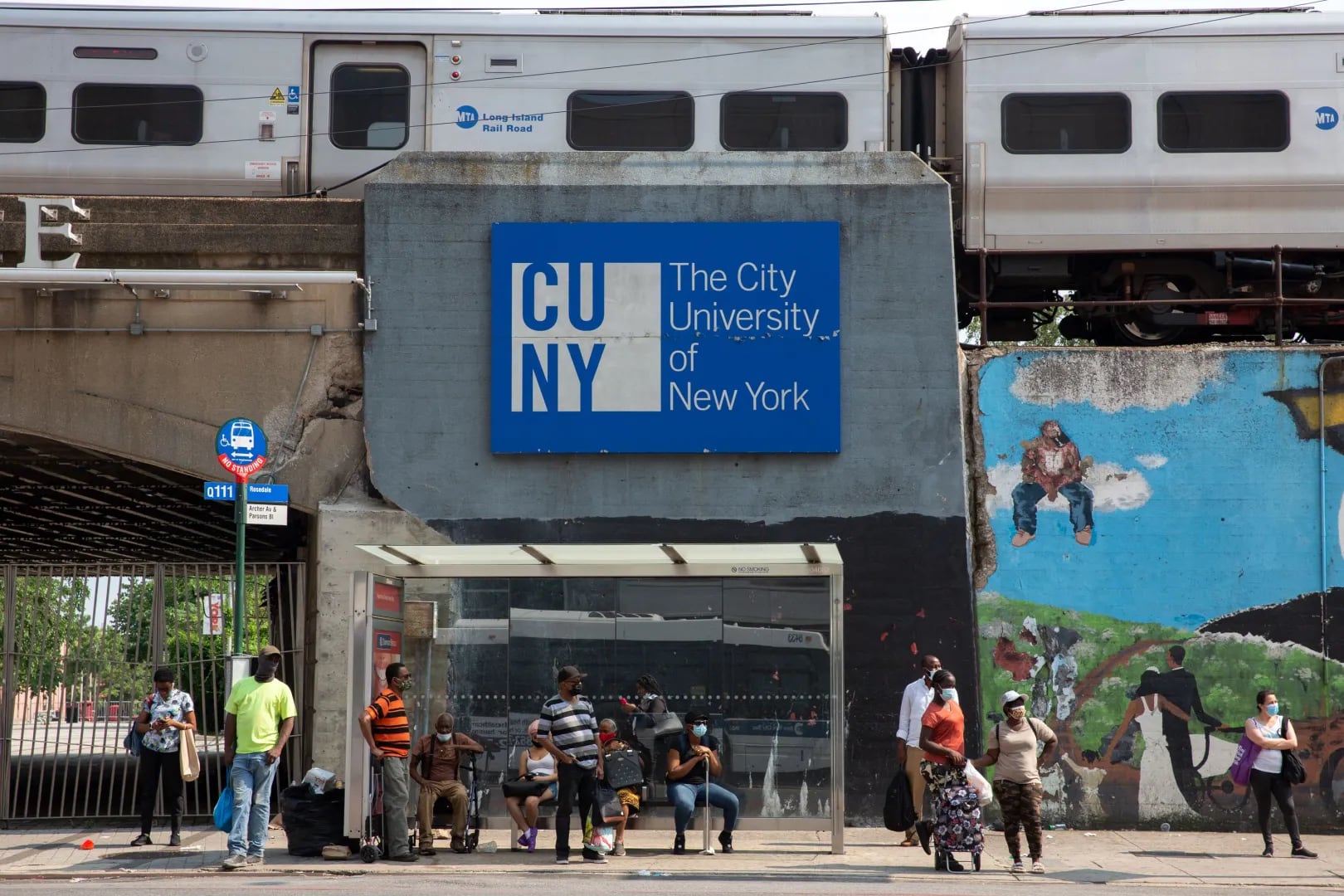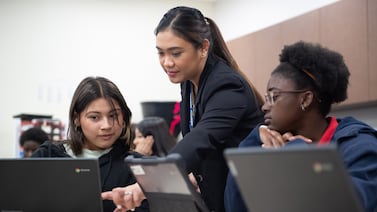This story was originally published on Aug. 1 by THE CITY. Sign up here to get the latest stories from THE CITY delivered to you each morning.
The CITY partners with Open Campus on coverage of the City University of New York.
Enrollment at the City University of New York is up for the first time in five years — which is still not enough to make up for the four consecutive years of losses that came before it. But the University is hoping its ubiquitous subway ads and outreach campaigns will help.
The 233,352 students who attended one of CUNY’s 25 schools in Fall 2023 was an increase of 21,368 from the previous year — but still down 41,554 compared to 2018, the last year that enrollment went up. And enrollment among Hispanic students, the largest single ethnic or racial group of CUNY students, is lagging, according to an analysis by THE CITY and Open Campus of CUNY’s internal enrollment data for Fall 2023, that was published this summer.
While the 3.5% increase in Hispanic enrollment for the 2023 school year was consistent with the 3.3% lift in total enrollment, that modest uptick has done little to reverse the sizable drop-offs for the group over the previous four years.
While the 3.5% increase in Hispanic enrollment for the 2023 school year was consistent with the 3.3% lift in total enrollment, that modest uptick has done little to reverse the sizable drop-offs for the group over the previous four years.
Even with last year’s gains, matriculation among Hispanic students fell by 18,835, or 22%, between Fall 2018 and Fall 2023 — considerably more than the overall 15% decline over that period.
“I think the pandemic kind of made people question, ‘is higher education as valuable as what we place on it? Are there other ways to achieve the goals I’m looking for without necessarily spending a lot of money and time?’” said Ayinde Bennett, a post-secondary access manager at the educational nonprofit Urban Assembly, who also noted how Latinx families had experienced disproportionate economic impact during the pandemic.
“I think with lower income, certainly Black and Latinx students, you probably are seeing more of a drop and more of a necessity maybe to work or to help out or support their families in some other way.”
Indeed, the downsizing in matriculation was particularly dramatic at the community college level, which generally enrolls greater shares of lower-income, first-generation, and Black and Brown students compared to senior colleges.
Overall, CUNY’s seven two-year colleges registered a 33.2% decrease in Hispanic enrollment amid a 21.5% decrease in total enrollment between Fall 2018 and Fall 2023, a far sharper drop than any other group.
By comparison, CUNY’s 11 senior colleges saw a 14% decrease in Hispanic enrollment and 12% decrease in total enrollment.
At Bronx Community College, for example, where 52% of students identified as Hispanic in Fall 2023 — the most of any CUNY school — enrollment fell by 42% between Fall 2018 and Fall 2023, including a 50% decline among Hispanic students, the most of any community college and the second-most system-wide.
Richard Ginsburg, the college’s spokesperson, like Bennett, also attributed the dramatic decline to the pandemic’s “significant impact” on the borough and its Hispanic population.
“Many students in underserved areas struggled with the shift to online learning due to inadequate technology and internet access, exacerbating the decline in enrollment,” he said, though noting that enrollment for this fall is looking up from last fall, “thanks to our continued efforts to focus on community engagement, digital inclusion, economic support, and holistic student services to reverse the enrollment decline and foster growth.”
National outlier
CUNY, however, reported just a 17% decline in Hispanic and Latino enrollment between Fall 2018 and Fall 2023 to the National Center for Education Statistics (NCES), which is 5 percentage points less than the 22% Hispanic decline registered under CUNY’s internal system.
(Schools that receive federal funding are required to report race- and gender-based enrollment data to the NCES’s Integrated Postsecondary Education Data Systems, commonly known as IPEDS.)
CUNY spokesperson Noah Gardy said the discrepancies are due to “numerous differences between CUNY’s internal race/ethnicity tracking and the IPEDS methodology, such as how students with multi-ethnic identities or nonresidents are categorized and reported.”
But even with those numbers, the drop in Hispanic enrollment at CUNY wasn’t mirrored nationally. Rather, IPEDS data show that public universities overall saw Hispanic enrollment tick up by 0.8% over the same five-year period even as total enrollment declined by 7%.
Gardy said this is because CUNY has “a student body with a larger proportion of low-income and Hispanic students than the national average,” and noted how the 25-school system consists of 16 colleges designated as Hispanic-serving institutions.
But CUNY is working to get on par — and it’s brought in outside help to move towards those goals.
In February, the University awarded a $425,000 contract for “marketing analysis and strategy consultant for CUNY enrollment,” New York State comptroller records show.
Gardy told THE CITY the analysis is still ongoing, but a report CUNY issued this year on “Stabilizing the University’s Finances” lays out the university’s plan to enroll 150,000 undergraduate students at senior colleges and 80,000 students at community colleges by 2030 — which would be 15% and 8% increases respectively from current levels.
And it will do so, the report stated, through “implementing innovative recruitment and retention strategies,” “diversifying of program offerings such as Online Programs or accelerated program,” and “revamping programs to ensure that they are meeting demands of students and employers.”
“Thanks to the hard work of enrollment and admissions at our campuses and centrally, enrollment is on the upswing,” Gardy said, pointing to a 10% increase in community college enrollment in Fall 2023 from the year prior. “Going forward we hope to build on this achievement and sustain CUNY as an engine of social mobility.”
‘Working on it’
Bennett, who used to be a college counselor at a majority Latinx high school, said CUNY would have to continue to bolster outreach and supportive services provided to prospective students to close the matriculation gaps.
“It’s a real nightmare for some students to navigate such a large institution like that, where getting support — and again it’s something CUNY’s working on — but it hasn’t always been there,” Bennett said.
He has encountered a number of CUNY students at two-year colleges, he added, who did not continue onto the system’s senior colleges because they struggled to navigate the complexities of financial aid while contemplating transfers.
At York College in Jamaica, Queens, enrollment management director Nick Jones told THE CITY that in-person outreach has been particularly successful in attracting some prospective students, particularly transfers, which is up 3.7% in Fall 2023 compared to the year before.
“You can always be online, but having conversations — tangible conversations — having people seeing our faces, seeing York College, shows that we want to make sure we have an impact on the community,” Jones said.
“We’re making sure we’re going out into the community, and in the high schools to make sure students know about us — and that they understand the SEEK and the ACE programs,” he continued, referring to two academic support programs available for students at a number of CUNY schools.
Gardy also pointed to a number of efforts CUNY’s central office has taken to boost enrollment and offer student support, including CUNY Reconnect, which has re-enrolled 16,319 students by paring them with advisors who help them navigate the re-entry process, as well as CUNY ASAP, which has so far provided more than 100,000 community college students with free tuition, textbook stipends and transportation benefits.
A CUNY report last year also boasts improved college enrollment among Black and Hispanic high school seniors who participate in its peer mentoring program.
For Medgar Evers College in Crown Heights, Brooklyn, where Hispanic enrollment experienced a 50% decline between Fall 2018 and Fall 2023 — the steepest of any CUNY schools — efforts to account for students’ need to work has also helped enrollment rebound between Fall 2022 and Fall 2023, said spokesperson Nick Masuda, when the number of Hispanic students grew by 8.6%.
“The educational journey took a backseat to helping their families adjust to an unprecedented worldwide health crisis,” Masuda said, referring to the pandemic’s impact on the area’s prospective students. “Our commitment to flexibility in a students’ schedule is a primary focus, making sure that each student can balance their personal and educational aspirations.”
And while enrollment woes have swept across many CUNY colleges, Kingsborough Community College in Brooklyn’s Manhattan Beach is one bright spot: Between Fall 2018 and 2023, Hispanic enrollment there jumped by 49%, while total enrollment increased by 27%.
Kingsborough spokesperson Cheryl Todmann credited those successes to the college’s strategic efforts in 2021 to boost its Hispanic student population in order to qualify for the federal Hispanic-Serving Institution status designation and related federal grants.
As part of the initiative, Toddman said Kingsborough’s multilingual recruiters offered Spanish-language information sessions and campus tours as part of the college’s “Sueños Empiezan Aquí,” or “Dreams Begin Here” campaign, and visited schools and NYCHA developments to promote the college’s flexible learning options in both English and Spanish. Meanwhile, the college also hired liaisons in Sunset Park to assist with college applications and registrations.
Also key to the college’s Hispanic enrollment growth, Toddman added, was its investments into a number of Spanish-language advertising campaigns placed across subways, bus shelters, radio, cable, newspaper and social media.
Gardy added: “Over the past two years CUNY has made a concerted and successful effort to raise awareness around the exceptional and affordable educational opportunities available to New Yorkers.”
Overall, according to state comptroller records, CUNY has planned to spend more than $12 million on advertising on Facebook, Spotify, and across the city since 2021 — most visibly on the MTA’s army of subway cars, commuter trains and buses.
One subway ad slogan reads “A Degree for Every Dream,” while another encourages onlookers to “Turn Your Internship Full Time. Launch your career with CUNY’s paid internship programs.”
Bennett, the post-secondary success expert who emphasized how many prospective students are now prioritizing economic mobility more than before, said he’s also noticed those dark blue posters as he traverses the city.
“CUNY is really trying to do a lot of rebranding as a city school for the city of New York, and are trying to work on connecting careers and employment with education,” Bennett said. “All of those are efforts to correct the course, like “How do we help them matriculate and see CUNY as a place of success?’
“I know CUNY is working on it like everyone else in the city.”







